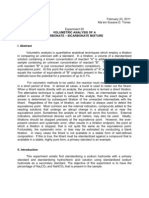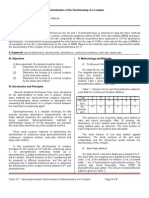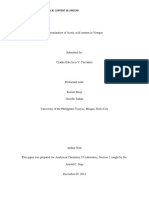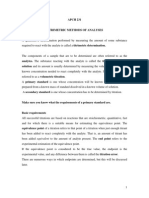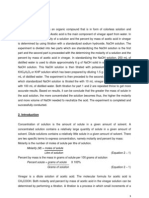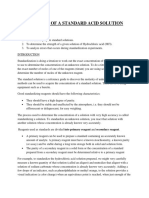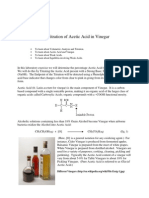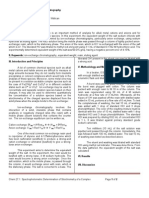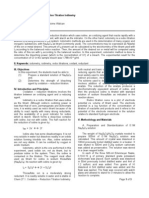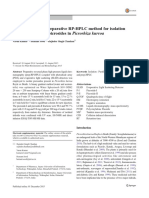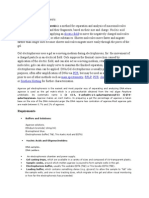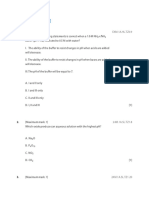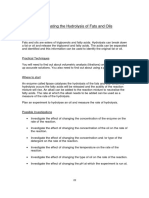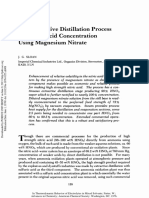Experiment 2 Chem 27.1 Standardization
Experiment 2 Chem 27.1 Standardization
Uploaded by
Alma PabilaneCopyright:
Available Formats
Experiment 2 Chem 27.1 Standardization
Experiment 2 Chem 27.1 Standardization
Uploaded by
Alma PabilaneOriginal Description:
Copyright
Available Formats
Share this document
Did you find this document useful?
Is this content inappropriate?
Copyright:
Available Formats
Experiment 2 Chem 27.1 Standardization
Experiment 2 Chem 27.1 Standardization
Uploaded by
Alma PabilaneCopyright:
Available Formats
Experiment 2: Determination of Total Acidity of Vinegar By Acid-Base Titration Pabilane, Alma L. & Group 6, Chem 27.1, SEJ1, Ms.
Noemi S. Walican December 11, 2010 I. Abstract Titration is an analytical procedure involving a chemical reaction in which the quantity of at least one reactant is determined volumetrically. Acid-Base titration involves neutralization reaction between an acid and a base. Its basis is the equivalence point, wherein the amount of the titrant added is stoichiometrically equivalent to the amount of analyte, thus, the concentration of the unknown can be calculated. Sodium hydroxide is the titrant used in titrating vinegar to determine its total acidity. It is standardized by titrating it against primary standard grade potassium hydrogen phthalate, a type of substance with very high purity, to determine the most accurate measurement of its concentration. Three trials were made for the standardization of the NaOH and 3 more trials in titrating the vinegar with it. The concentration of the vinegar (molarity, %(w/v)) in each trial is given by: 0.48M, 2.88%; 0.46M, 2.76%; 0.42M, 2.52%; 0.44M, 2.64%, respectively. The average experimental concentration in molarity and in %(w/v) of the vinegar as determined is 0.45M, and 2.721%, respectively, with a standard deviation of 0.155, relative SD of 5.7 ppt, and CI (at 95%) of 0.152. The true value for the molarity of the vinegar is 0.4995M and for %(w/v), is 3.000%, thus, giving an experimental error of -9.91%.
II. Keywords : titration, vinegar, acid, base, titrant, indicator dissolving it in 300 ml CO2 free, distilled water in a 500-ml beaker, and then, transferred into 1-L PET bottle and tightly closed. For the standardization of the titrant (0.1M NaOH), in a 250-ml Erlenmeyer flask, 0.50 0.51 g of dried primary standard grade potassium hydrogen phthalate (KHC8H4O4) was placed. Immediately before titration, 25 ml CO2-free distilled water and 2 drops of phenolphthalein were added to the KHC8H4O4 in the Erlenmeyer flask. The solution was titrated with 0.1M NaOH, with continuous swirling while adding the titrant, until the end point was reached, indicated by the faint pink coloration of the solution. This was done for three times. The molarity of NaOH was calculated in each standardization using the formula M1V1 = M2V2. Then the average molarity (or the mean value) of NaOH was also computed. For the titration of unknown (determination of acidity of vinegar), 5 ml of the diluted vinegar (with unknown concentration) was placed into a 250-ml Erlenmeyer flask. Five ml of CO2-free water and 2 drops of phenolphthalein were added. The solution was titrated with the standardized NaOH solution, with continuous swirling while adding the titrant, until the end point was reached, indicated by faint pink coloration of the solution. The molarity of the vinegar was calculated using the formula M1V1 = M2V2. V. Results
III. Introduction Vinegar is a substance that is widely used in daily living. It is a sour-tasting liquid that is commonly used as a condiment and a preservative. It contains many organic acids. Among these acids, acetic acid (CH3COOH, a weak acid) is the one present in larger amount compared to the other. Vinegar is taken in by the human body. The concentration of the vinegar must fall in the range that is allowable for human consumption (which is usually, 4-8% by volume). Therefore, vinegar manufacturers control and monitor the acidity of vinegar. In this experiment, acid-base titration will be used to determine the concentration of vinegar, its total acidity, and not the concentration of acetic acid alone. The basic principle of titration is neutralizing the analyte (substance with unknown concentration, vinegar, in the experiment) with the titrant (substance with known concentration, usually strong acid/base, in the experiment, NaOH). When equivalent point is reached, that is, amount of analyte equals the amount of titrant, the concentration of the analyte can be calculated. But experimentally, the end point is the one determined, a point which is very close to the equivalence point. This experiment will help us know whether the vinegar is safe to be taken in by human. IV. Experimental
For the experiment, 1 L of 0.10 molar of Reactions involved: sodium hydroxide (0.1M NaOH) was prepared by dissolving approximately 4.0 g of NaOH pellets and Standardization of NaOH solution: Chem 27.1. Determination of Total Acidity of Vinegar by Acid-Base Titration. Page 1 of 3
KHC8H4O4(s) + H2O(l) KC8H4O4 (aq) + H3O
+ -
+ (aq)
% Error = 2.7027 3.000 x 100 = - 9.91 % 3 VI. Discussion For human consumption, the usual concentration of acetic acid in vinegar is only about 4-8% by volume. In the experiment, acid-base titration was used to determine the acidity of a vinegar with unknown concentration. Titration is a method of analysis that is useful in determining the concentration of an unknown using the by reacting it completely with a solution of a known concentration. The substance of unknown concentration being titrated is called the analyte and the one being reacted with the analyte (the one with known concentration) is called the titrant. The titrant is delivered into the flask containing the analyte using the buret. The titrant used is usually strong acid/base so that the reaction is irreversible. In the experiment, NaOH reacts with CH 3COOH to form the salt sodium acetate and water. The equivalence point of a titration refers to that point when an amount of titrant that has been added is stoichiometrically equivalent to the amount of analyte present. For the experiment it is the point when number of moles of vinegar (or the acetic acid) equals the number of moles of NaOH, for the reaction to be complete. According to experimental results, approximately 21-25 ml NaOH is needed to react completely with the vinegar. (Note that this is quite a wide range). The end point refers to the experimental approximation of the equivalence point, since the latter is difficult to determine. Indicators, such as phenolphthalein as used in the experiment, are used to detect the end point. Phenolphthalein is a very weak acid, and is colorless in acidic solution and turns to pink in basic solution. Thus, the end point is indicated when a faint pink color appears in the solution. During titration, one will know that the equivalence point is near when the pink color disappears more and more slowly. For a more accurate titration, the titrants concentration must be known as near to the true value as possible. In the experiment, NaOH was prepared in an approximate concentration of 0.1 molar. Then, it was titrated against primary standard grade potassium hydrogen phthalate (KHC8H4O4). This process is called standardization which is used to determine the exact concentration (or the most accurate, as possible) of the titrant. Primary standard grade of the substance to be used in standardization is necessary because it has very high purity and possess other qualities that will be helpful to get the most accurate result, like stability Page 2 of 3
KHC8H4O4(aq) + NaOH(aq) Na K C8H4O4 (aq)+ H2O HPhe(aq) + H2O(l) Phe (aq) + H3O Analysis of unknown: CH3COOH(aq)+ H2O(l) CH3COO (aq)+ H3O
+ + (aq) + (aq)
CH3COOH(aq) + NaOH(aq) Na CH3COO (aq) + H2O(aq) HPhe(aq) + H2O(l) Phe (aq) + H3O Results Standardization: Trial Weight of KHC8H4O4 (g) 0.5009 0.5075 0.5035 Volume of NaOH (ml) 25.05 25.13 25.05 Molarity of NaOH 0.098 0.099 0.0984
+ (aq)
1 2 3
Average Molarity= 0.098 + 0.099 + 0.09844 = 0.0985 M 3 Standard Deviation: 5.01 x 10 Relative Standard Deviation (in ppt): 5.08 Analysis of Unknown: Trial 1 2 3 4 5 6 V NaOH (ml) 24.35 23.75 23.45 22.15 21.35 21.65 M of vinegar 0.48 0.46 0.42 0.44 %(w/v) of vinegar 2.88 2.76 2.52 2.64
-4
Average %(w/v) of vinegar= [(0.48mol/L/ 60.06 g/mol)x(1 L/1000ml)x100] + [(0.46mol/L/ 60.06 g/mol)x(1 L/1000ml)x100] + [(0.42mol/L/ 60.06 g/mol)x(1 L/1000ml)x100] + [(0.44mol/L/ 60.06 g/mol)x(1 L/1000ml)x100] + 4 = 2.7027% Standard Deviation: 0.155 Relative Standard Deviation: 5.7 (ppt) CI at 95% Confidence Level = (1.96x0.155)/ 4 = 0.152
Chem 27.1. Determination of Total Acidity of Vinegar by Acid-Base Titration.
in solid form and high equivalent weight (to minimize relative error in weighing). The results of the standardization in the experiment showed that the titrant NaOH has a concentration of approximately 0.0985M (this is the mean of the molarities of NaOH in the 3 trials which were computed by getting the number of moles of KHC8H4O4 divided by the volume of NaOH used in liters). The concentration of the vinegar as determined in the experiment is 0.45M or 2.721% (w/v), while the true value is 0.4995M or 3.00% (w/v). The experiment has an experimental error of -9.91% (indicating that the experimental result is less than the true value). VII. Conclusion and Recommendations The acid content of a vinegar is present in a very low amount (4-8%) for human consumption, and it cannot exceed because it may have bad effects to human body. Titration is a useful method in determining amount/concentration of a substance of unknown concentration. But, it greatly depends on purity of the reagents being used, especially the titrant. Use of primary standard grade substance is necessary in standardization of the titrant. It is highly recommended that experimenters make sure that the water being used is distilled and carbon dioxide-free, because, carbon dioxide may also react with water. Proper ways of measurement must also be done in measuring volumes and masses to avoid causing errors in the data. Proper lab techniques must also be observe, e.g. make sure there is no bubble at the tip of the buret, and do half-dropping when the equivalence point is near. Experimenters must always wear personal safety equipment such as lab gowns, gloves, masks and goggles and always follow the procedure in the manual to avoid unwanted accidents. Wastes must be segregated and disposed properly, in their proper waste bottles. Acids/bases must be neutralized first. Solid wastes must be put in the right trash bin and not in the sink. VIII. References 1. Brown T., LeMay H., Bursten B. (2002). th Chemistry the Central Science 8 ed. Pearson Education Asia Pte. Ltd. Singapore. 2. Hargis, L. (1988). Analytical Chemistry. Prentice-Hall, Inc. New Jersey. 3. Determining Molar Concentration of Vinegar by Titration. Retrieved from:
http://web.lemoyne.edu/~giunta/chm151L/vi negar.html on Dec. 9, 2010. 4. Helmenstine, A. Titration Basics. Retrieved from: http://chemistry.about.com/od/acidsbases/a /aa082304a.htm on Dec. 9, 2010. 5. Titrations, Indicators, and Titration Curves. Retrieved from http://www.avogadro.co.uk/chemeqm/acidb ase/titration/phcurves.htm on Dec 9, 2010.
I hereby certify that I have given substantial contribution to this report. _______________________ MARIE GIECEL
_______________________ ALMA PABILANE
Chem 27.1. Determination of Total Acidity of Vinegar by Acid-Base Titration.
Page 3 of 3
You might also like
- Experiment 5 - Double Indicator TitrationDocument16 pagesExperiment 5 - Double Indicator TitrationJoemer Absalon Adorna71% (7)
- Lab Report Acid in VinegarDocument18 pagesLab Report Acid in VinegarIustina Valentina50% (2)
- Lab 3 - Titration of Soda - Citric AcidDocument9 pagesLab 3 - Titration of Soda - Citric AcidAndrea Satira100% (1)
- LAB REPORT - Determination of Concentration Acetic Acid in VinegarDocument12 pagesLAB REPORT - Determination of Concentration Acetic Acid in Vinegarhisham100% (4)
- Lab Report DETERMINATION OF THE CONCENTRATION OF ACETIC ACID IN VINEGARDocument27 pagesLab Report DETERMINATION OF THE CONCENTRATION OF ACETIC ACID IN VINEGARمحمد ازوادي100% (1)
- Lab Report (Vinegar)Document17 pagesLab Report (Vinegar)SazrinaMohdSafar100% (4)
- Experiment 4 5 6 PDFDocument14 pagesExperiment 4 5 6 PDFreay jiNo ratings yet
- Carbonate-Bicarbonate Mixture Anal Chem Post LabDocument7 pagesCarbonate-Bicarbonate Mixture Anal Chem Post LabKennedy OrtegaNo ratings yet
- Post Lab 8 - Chem 8Document3 pagesPost Lab 8 - Chem 8Christi ViajeNo ratings yet
- Experiment No. 3 Determination of Acetic Acid Content in VinegarDocument14 pagesExperiment No. 3 Determination of Acetic Acid Content in VinegarClandy CoNo ratings yet
- Experiment 7 - Spectrophotometric DeterminationDocument5 pagesExperiment 7 - Spectrophotometric DeterminationAlma Pabilane96% (24)
- Tracerase: Operating and Instruction ManualDocument16 pagesTracerase: Operating and Instruction ManualKrishnaNo ratings yet
- Lab Report 1Document23 pagesLab Report 1AmeerRashidNo ratings yet
- Determination Acetic AcidDocument21 pagesDetermination Acetic Acidameyakem100% (1)
- Lab 1 Determination of Acetic Acid in VinegarDocument17 pagesLab 1 Determination of Acetic Acid in Vinegarieja03100% (4)
- Experiment 1: Determination of Total Acidity of Vinegar: Final Laboratory ReportDocument13 pagesExperiment 1: Determination of Total Acidity of Vinegar: Final Laboratory ReportEunice OpinioNo ratings yet
- Practice Nº1 Acid Base VolumetryDocument6 pagesPractice Nº1 Acid Base VolumetryScribdTranslationsNo ratings yet
- Determinate of The Concentration of Acetic Acid in VinegarDocument22 pagesDeterminate of The Concentration of Acetic Acid in VinegarSYahira HAzwaniNo ratings yet
- Determination of Acetic Acid Content in Vinegar: Experiment 3Document13 pagesDetermination of Acetic Acid Content in Vinegar: Experiment 3Maelyn Nicole Tan RominNo ratings yet
- No. Pages: Table of ContentDocument18 pagesNo. Pages: Table of ContentAzzian AriffinNo ratings yet
- ManualDocument10 pagesManualhannan sharizalNo ratings yet
- Major Chemicals Used in Textile Wet ProcessingDocument6 pagesMajor Chemicals Used in Textile Wet ProcessingMirza Farid Hasan RonyNo ratings yet
- Lab 1 Determination of Acetic Acid in VinegarDocument20 pagesLab 1 Determination of Acetic Acid in Vinegaramiraaikharah100% (1)
- Chemistry Lab Report1Document22 pagesChemistry Lab Report1RoseAnne BellaNo ratings yet
- Experiment 1: Determination of Total Acidity of Vinegar: Final Laboratory ReportDocument11 pagesExperiment 1: Determination of Total Acidity of Vinegar: Final Laboratory ReportJAN JERICHO MENTOYNo ratings yet
- A Volumetric AnalysisDocument10 pagesA Volumetric AnalysisTDUY059109No ratings yet
- Chemistry Report - Titration of VinegarDocument7 pagesChemistry Report - Titration of VinegarSabestNo ratings yet
- Vinegar Titration LAB 1Document22 pagesVinegar Titration LAB 1Amirah AbidinNo ratings yet
- Che485 Lab1 Mac2023 Ceeh2202f 2023389329Document17 pagesChe485 Lab1 Mac2023 Ceeh2202f 2023389329Wan AfiqNo ratings yet
- Lab ReportDocument21 pagesLab ReportaleeyazahardiNo ratings yet
- Meralco FinalDocument8 pagesMeralco FinalPancho CakesNo ratings yet
- Framework On VinegarDocument14 pagesFramework On VinegarNicole TiancoNo ratings yet
- Lab Report 1Document10 pagesLab Report 1Alex XanderNo ratings yet
- Lab Report Acid in VinegarDocument18 pagesLab Report Acid in VinegarAmirah Nadia Mat Lias89% (19)
- Che485 Lab 1 Determination of The Concentration of Acetic Acid in VinegarDocument25 pagesChe485 Lab 1 Determination of The Concentration of Acetic Acid in VinegarNOR FARISHA MASTURA FISSOLNo ratings yet
- Che485 Lab1 Mac2023 Ceeh2202fDocument19 pagesChe485 Lab1 Mac2023 Ceeh2202f2023389329No ratings yet
- TitrationDocument12 pagesTitrationMiranda Amiroh SulaimanNo ratings yet
- Vinegar Analysis Via Titration 1Document18 pagesVinegar Analysis Via Titration 1ben richNo ratings yet
- Lab 1 AcidityDocument8 pagesLab 1 AcidityEngr Arafat QubatiNo ratings yet
- Ana ChemDocument12 pagesAna ChemShella Mare CanizaresNo ratings yet
- Determination of The Concentration of Acetic Acid in VinegarDocument16 pagesDetermination of The Concentration of Acetic Acid in VinegarFirdaus HaziqNo ratings yet
- Titrimetric Methods of AnalysesDocument10 pagesTitrimetric Methods of AnalysesJason BakerNo ratings yet
- 17.0 Qualitative and Quantitative AnalysisDocument5 pages17.0 Qualitative and Quantitative AnalysisHry WkNo ratings yet
- Experiment No. 8 Acid-Base TitrationDocument15 pagesExperiment No. 8 Acid-Base TitrationHazel King50% (2)
- Determination of The Concentration of Acetic Acid in VinegarDocument20 pagesDetermination of The Concentration of Acetic Acid in VinegarAthirah Hanafi78% (9)
- Preparation of A Standard Acid SolutionDocument4 pagesPreparation of A Standard Acid SolutionfaithNo ratings yet
- lab work 3Document13 pageslab work 3sido sidomerNo ratings yet
- Chapter 5 P1Document46 pagesChapter 5 P1isfaNo ratings yet
- Experiment 3 - Acid and Base TitrationDocument17 pagesExperiment 3 - Acid and Base TitrationJoemer Absalon Adorna100% (3)
- Lab 1Document18 pagesLab 1Syah MieNo ratings yet
- Exp 3 - Acid Daffa Madri AthaDocument6 pagesExp 3 - Acid Daffa Madri Athadaffa MadriNo ratings yet
- Concentration ReportDocument27 pagesConcentration ReportfarahhanamejeniNo ratings yet
- Chemistry ReportDocument5 pagesChemistry ReportAngel Trisha Mae DelMundoNo ratings yet
- The Titration of Acetic Acid in Vinegar: CHEM 122L General Chemistry Laboratory Revision 1.4Document16 pagesThe Titration of Acetic Acid in Vinegar: CHEM 122L General Chemistry Laboratory Revision 1.4Nur Najwa YunusNo ratings yet
- Old Is GoldDocument3 pagesOld Is GoldJofreyNo ratings yet
- Vinegar Analysis Via Titration 1Document18 pagesVinegar Analysis Via Titration 1Joaquin MoulicNo ratings yet
- Experiment 3 (Chem 26.1)Document7 pagesExperiment 3 (Chem 26.1)Maelyn Nicole Tan RominNo ratings yet
- Lab Format:: Lab 8: Determination of Acetic Acid Content in VinegarDocument5 pagesLab Format:: Lab 8: Determination of Acetic Acid Content in VinegarqemaismailNo ratings yet
- ANAS - Anal ChemDocument12 pagesANAS - Anal Chemnoraliah 21No ratings yet
- Experiment No.4Document5 pagesExperiment No.4alandanwar266No ratings yet
- Advanced Pharmaceutical analysisFrom EverandAdvanced Pharmaceutical analysisRating: 4.5 out of 5 stars4.5/5 (2)
- Practical Manual of Analytical ChemistryFrom EverandPractical Manual of Analytical ChemistryRating: 4.5 out of 5 stars4.5/5 (3)
- 127.1 E6 Formal ReportDocument7 pages127.1 E6 Formal ReportAlma PabilaneNo ratings yet
- Chem157.1 Experiment 7 Chemical EquilibriumDocument44 pagesChem157.1 Experiment 7 Chemical EquilibriumAlma Pabilane100% (4)
- Chem 156.1 Experiment 8 (Lattice, Solution, Hydration)Document9 pagesChem 156.1 Experiment 8 (Lattice, Solution, Hydration)Alma Pabilane50% (2)
- Experiment 9-Ion Exchange ChromatographyDocument2 pagesExperiment 9-Ion Exchange ChromatographyAlma Pabilane100% (3)
- Chem 156.1 Experiment 8 (Solution, Lattice, Hydration)Document54 pagesChem 156.1 Experiment 8 (Solution, Lattice, Hydration)Alma PabilaneNo ratings yet
- Experiment 5 - Oxidation-Reduction Titration IodimetryDocument3 pagesExperiment 5 - Oxidation-Reduction Titration IodimetryAlma Pabilane75% (12)
- Experiment 9-Ion Exchange ChromatographyDocument2 pagesExperiment 9-Ion Exchange ChromatographyAlma Pabilane100% (3)
- Chem 31: Reviewer For 2 DepexDocument27 pagesChem 31: Reviewer For 2 DepexAlma PabilaneNo ratings yet
- Optimization of A Preparative RP-HPLC Method For Isolation and Purification of Picrosides in Picrorhiza KurroaDocument7 pagesOptimization of A Preparative RP-HPLC Method For Isolation and Purification of Picrosides in Picrorhiza KurroaSumit JoshiNo ratings yet
- Titrimetric Determination of Sulfate Method 1 - Ca ISE: Application Bulletin 140/4 eDocument15 pagesTitrimetric Determination of Sulfate Method 1 - Ca ISE: Application Bulletin 140/4 eKiswan SetiawanNo ratings yet
- Affinity ChromatographyDocument3 pagesAffinity ChromatographyReeba KuruvillaNo ratings yet
- TGP-15 Pmi & PmacDocument27 pagesTGP-15 Pmi & PmaciplaruffNo ratings yet
- Le Chatelier's Principle FundamentalsDocument5 pagesLe Chatelier's Principle FundamentalsreddygrNo ratings yet
- DPP 04 Ionic Equilibrium JH Sir-4172Document4 pagesDPP 04 Ionic Equilibrium JH Sir-4172Shivam KumarNo ratings yet
- AQUACID 101 EX Lote 1020015695 & BPY0021-01Document1 pageAQUACID 101 EX Lote 1020015695 & BPY0021-01Julio . CNo ratings yet
- Science Lab PDFDocument8 pagesScience Lab PDFsamuel.moryoussefNo ratings yet
- Oran 2Document263 pagesOran 2KerimberdiNo ratings yet
- Agarose Gel ElectrophoresisDocument3 pagesAgarose Gel ElectrophoresisAbhijitBoruah100% (1)
- Valorador Titulador Hi 84532Document44 pagesValorador Titulador Hi 84532AngelaNo ratings yet
- GC Handbook A Complete OverviewDocument249 pagesGC Handbook A Complete OverviewbesserianiNo ratings yet
- 8.2 Properties of Acids and BasesDocument24 pages8.2 Properties of Acids and Baseslobna masadehNo ratings yet
- 3.1 (2) chemDocument23 pages3.1 (2) chemprishanankani9No ratings yet
- USP-NF Hydroxyzine HydrochlorideDocument4 pagesUSP-NF Hydroxyzine Hydrochlorideeldridatech pvt ltdNo ratings yet
- 5 Minute Analysis of Vitamin D in Serum by LC/MS/MSDocument3 pages5 Minute Analysis of Vitamin D in Serum by LC/MS/MSSuyog patil100% (1)
- Chem 4Document3 pagesChem 4Lovey ChandiNo ratings yet
- Journal Alpha Glucosidase Inhibitory Activity and Fractionation ofDocument5 pagesJournal Alpha Glucosidase Inhibitory Activity and Fractionation ofVincent ReyesNo ratings yet
- Gujarat Technological UniversityDocument2 pagesGujarat Technological UniversityShivam PanchalNo ratings yet
- Development of Sorbtsion-Spectroscopic Method of Determining Copper (II) Ion With Dimethylglioxime Using Immobilized Organic ReagentDocument4 pagesDevelopment of Sorbtsion-Spectroscopic Method of Determining Copper (II) Ion With Dimethylglioxime Using Immobilized Organic ReagentCentral Asian StudiesNo ratings yet
- Calbiochem Buffers BookletDocument37 pagesCalbiochem Buffers Bookletemail00001No ratings yet
- Acid-Base Titration QuestionDocument3 pagesAcid-Base Titration QuestionDonovan KwanNo ratings yet
- Fat HydrolysisDocument4 pagesFat HydrolysisAjay Rawat100% (1)
- Wis Ap Chem Lab 17 Buffer Solutions ArcherDocument7 pagesWis Ap Chem Lab 17 Buffer Solutions Archerapi-201479236No ratings yet
- MassSpectrometry (MS)Document33 pagesMassSpectrometry (MS)KassimNo ratings yet
- The Extractive Distillation Process For Nitric Acid Concentration Using Magnesium NitrateDocument15 pagesThe Extractive Distillation Process For Nitric Acid Concentration Using Magnesium NitrateAlejandro Duvan Lopez RojasNo ratings yet
- ASTM Volume 03.05, October 2018 Analytical Chemistry For Metals, Ores, and Related MaterialsDocument3 pagesASTM Volume 03.05, October 2018 Analytical Chemistry For Metals, Ores, and Related Materialssanthosh dsNo ratings yet
- Acid-Base Lesson PlanDocument5 pagesAcid-Base Lesson Planapi-334089809No ratings yet
- Distillation Tower: 1. ObjectiveDocument17 pagesDistillation Tower: 1. ObjectiveEtikNo ratings yet







